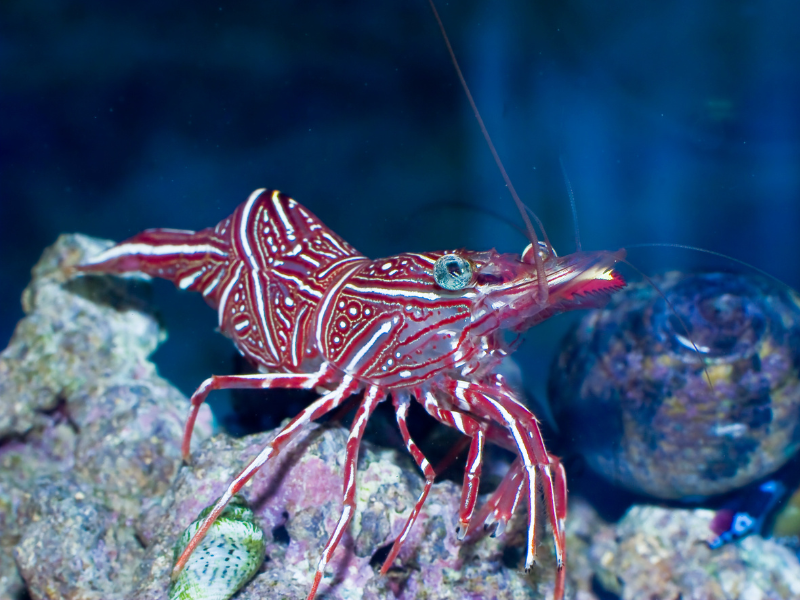Rhynchocinetes uritai
Camel Shrimp

Scientific Classification
Quick Stats
Aquarium Building Information
About This Species
Basic Description
Detailed Description
Native to the vast Indo-Pacific region, the Camel Shrimp is a fascinating crustacean that brings a high level of activity to a saltwater aquarium. Its natural habitat consists of reef environments with moderate water movement, a condition that should be replicated in the home aquarium to ensure its well-being. These shrimp are best suited for established tanks that have developed a healthy layer of biofilm, which serves as a natural food source. A secure lid is non-negotiable, as their inquisitive and agile nature makes them notorious escape artists.
In terms of social structure, this species exhibits behaviors that can vary depending on the gender makeup of the group. It is highly recommended to keep them in groups rather than individually, as this allows them to feel secure and display their full range of natural behaviors. They occupy the lower levels of the aquarium, constantly exploring caves and crevices. Their peaceful disposition makes them compatible with a wide range of tank mates, though they are small and can be vulnerable to larger, predatory fish.
As omnivorous scavengers, their diet is straightforward. They will readily consume a variety of commercially available foods, including frozen preparations, sinking pellets, and flake food that settles on the bottom. Their role as detritivores makes them a functional part of a clean-up crew, as they help manage waste by consuming uneaten food and other organic matter. A daily feeding schedule is appropriate to support their moderate metabolism. Maintaining stable water parameters, including temperature, pH, and salinity, is crucial for their health. The challenge in their care lies not in their diet or temperament, but in the need for a consistently stable marine environment, which places them in the medium difficulty category for aquarists.
Scientific Description
Rhynchocinetes uritai is a decapod crustacean belonging to the family Rhynchocinetidae, a group commonly referred to as hinge-beak shrimps. This nomenclature is derived from their distinct, upward-pointing rostrum that is movably articulated with the carapace. Morphologically, the species exhibits a compressiform body shape, which is laterally compressed, allowing for excellent maneuverability within the complex structures of coral reefs. Originating from the Indo-Pacific, this species is adapted to the stable environmental parameters of tropical marine ecosystems, requiring warm temperatures, alkaline pH, and specific water hardness and salinity ranges.
Ecologically, R. uritai functions as an omnivorous micro-predator and scavenger. Its diet in situ would consist of small organisms, detritus, and algae or biofilm, and it retains this feeding behavior in captivity. This dietary habit classifies it as a consumer of detritus and biofilm, contributing to nutrient cycling within a closed system. Its physiological demands are moderate; it has a medium metabolic rate, coupled with low oxygen consumption and waste production, resulting in a low bioload factor relative to its size. This makes it an efficient organism within a balanced aquarium ecosystem.
Reproductive biology is complex, with successful propagation in captivity noted as requiring special conditions. This is typical for many marine arthropods that undergo a planktonic larval phase, which demands specific environmental cues and feeding regimens that are difficult to replicate. From a conservation standpoint, Rhynchocinetes uritai is listed as Not Evaluated (NE) by the IUCN, indicating that its population status and potential threats in the wild have not been formally assessed.
Breeding Description
Breeding the Camel Shrimp in a home aquarium is considered a significant challenge and is typically only achieved by advanced hobbyists with dedicated systems. The primary difficulty stems from the complex requirements of its larval stage.
To initiate breeding, a healthy, mature group should be established in a stress-free environment that mimics their natural habitat with stable water parameters. A small group is recommended to increase the chances of having both males and females, as their social dynamics and pairing are dependent on gender. Sexing these shrimp can be difficult, as sexual dimorphism is not always obvious to the casual observer. Generally, females may be larger and have a broader abdomen for carrying eggs. After a successful mating, the female will carry a clutch of eggs under her swimmerets. She will tend to them, keeping them clean and aerated until they hatch.
Upon hatching, the shrimp release a large number of tiny, free-swimming larvae, not fully formed shrimplets. This is the most critical and challenging phase. The larvae are planktonic and must be moved to a separate, dedicated rearing tank with gentle, circular water flow and no mechanical filtration that could pull them in. The greatest hurdle is providing an appropriate food source. The larvae are incredibly small and require microscopic foods, such as cultured phytoplankton and newly hatched rotifers or copepods, during their various developmental stages. This requires the aquarist to maintain separate live food cultures. The larval period is prolonged, and maintaining pristine water quality without a standard filter, while constantly providing food, is extremely difficult. Most breeding attempts fail at this stage due to starvation or degradation of water quality.
Generate Printable Card
Create a printable card for this creature to display in your store or aquarium. The card includes a QR code for quick access to more information.